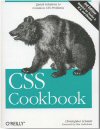My Articles & Presentations
Professional Development
Resume
Services I Provide
Testimonials
How I Work
New Clients
Disaster Preparedness
CSS Cookbook, 3rd edition
Originally published in Technical Communication, Vol. 58, No. 4
Christopher Schmitt. 2010. Sebastopol, CA: O'Reilly Media. [ISBN 978-0-596-15593-3. 704 pages, including index. US$49.99 (soft cover).]
 This is the third iteration of this reference on coding with cascading style sheets (CSS). Browsers have evolved since the first published edition in 2004, and Schmitt's compendium has attempted to incorporate these changes. As with almost all technology books, however, the technology—browser support for specific features—changes faster than the time it takes to write, edit, publish, and sell a book. As a result, some browser limitations noted in the print version may no longer apply by the time a coder uses the CSS Cookbook. There is an online edition, but it is only free of charge for 45 days after entering the coupon code from the print version.
This is the third iteration of this reference on coding with cascading style sheets (CSS). Browsers have evolved since the first published edition in 2004, and Schmitt's compendium has attempted to incorporate these changes. As with almost all technology books, however, the technology—browser support for specific features—changes faster than the time it takes to write, edit, publish, and sell a book. As a result, some browser limitations noted in the print version may no longer apply by the time a coder uses the CSS Cookbook. There is an online edition, but it is only free of charge for 45 days after entering the coupon code from the print version.
CSS Cookbook is not intended to be read cover to cover. Instead, readers can look up the "recipe" for the particular task they want to accomplish. Even though the current CSS 2.1 standard offers many more options than 1.0 did, the "Hacks and Workarounds" section is still one of the most useful portions of the book. Other helpful information includes notes on accessibility (did you know that right-justified text is difficult to read for dyslexics?) and an appendix listing all CSS properties, their values and defaults.
Each "recipe" outlines the problem this particular item is intended to solve, the solution itself (including sample code), a discussion of how that solution works, known browser issues with this item, and a "see also" section referring to further information elsewhere on the Web. Many "recipes" also include screen shots and other graphic elements. While many "before and after" shots help readers visualize how exactly this particular solution changes the display of text or graphics, some add little to the text. A few screen shots are downright confusing, as when a caption purports to show the effect of a selector on an ordered list, but the corresponding image shows an unordered list.
Somewhat perplexing also is the inclusion of a chapter on HTML basics. According to the preface, CSS Cookbook assumes the reader "possess[es] some web design or development experience" (p. xviii). Presumably, anyone with such experience would not require an explanation of how to code a basic HTML page. While leaving that chapter and some of the less helpful illustrations out would not have slimmed the volume down to the 240 or so pages of its first edition, it might have made the book somewhat easier to handle (not to mention saving some paper).
All in all, however, CSS Cookbook still is a useful and comprehensive reference for web coders of all stripes.
After writing software documentation and managing an IT department, Barbara Jungwirth now translates technical documents from German to English and codes for an HIV Web site. She owns reliable translations (www.reliable-translations.com) and writes a blog, On Language and Translation (http://reliable-translations.blogspot.com/).